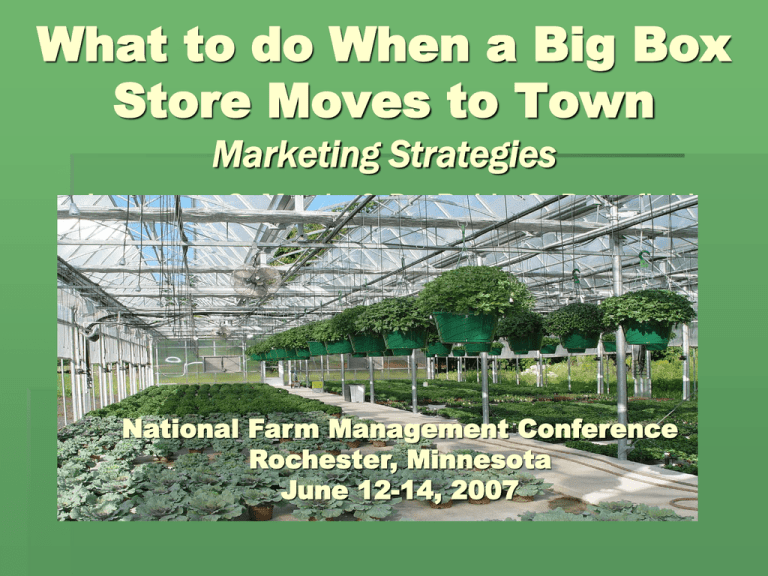What to do When a Big Box Store Moves to Town
advertisement

What to do When a Big Box Store Moves to Town Marketing Strategies Lawrence S. Martin & Dr. Robin G. Brumfield National Farm Management Conference Rochester, Minnesota June 12-14, 2007 A Tale of Two Cities.... Both Have: A New Big Box Two Established Greenhouse/Nurseries A Tale of Two Cities……. Two years after Home Depot comes to town..... One grower goes The other grower? A Tale of Two Cities……. How????? Why??? Marketing Trends: How are greenhouses (wholesale and/or retail) coping with changing customer preferences while at the same time competing with and/or profitably selling to the Big Boxes? Marketing Trends: Our work is meant to help growers formulate their own: Strategies Concepts Ideas ...to not only SURVIVE; but, to THRIVE in the current, competitive market. Materials and Methods: Marketing Strategies Visited over 80 growers Collected data on: Maintaining market share Promotional plans & programs Product mix Value added Agri-entertainment Advertising Pricing policies Demographics Market channels Objective #1 Determine how the Green Industry is responding to current trends & changing customer preferences. Objective #2 What can producers learn from our research results? Objective #3 How can they incorporate these results into their existing marketing programs? Marketing Trends: The Big Boxes FACT: The Big Boxes are here to stay! Big Boxes: Help or Hindrance? Big Boxes are Price Setters & Push Prices Down Contributing to or causing………… Shake-Outs: elimination or winnowing out of some competing businesses as a result of intense competition. Contributing to or causing………… Bankruptcies: A bankrupt business is one which has been legally declared financially insolvent. Contributing to or causing………… Consolidation: The merger of two or more commercial interests or corporations. Big Boxes’ low prices are sometimes BELOW break-even costs. Marketing Trends: When a Big Box store moves into town most reactive/resulting strategies boiled down to: “Snooze & Loose” or “Change & Prosper.” Marketing Trends: Producers who: Changed or modified their long established marketing histories not only stayed/remained solvent but increased their sales in the shadow of the Big Boxes. Tale of Two Independents: “Snooze & Loose” or “Change & Prosper” Qualified as “Easy Prey” for Big Boxes” A typical Main St. Merchant doing “business as usual” for one or more generations. Invested little profits back into business Complacent. Store Fronts neglected. Cracked Sidewalks. Litter in the gutters. Parking Meters answer to limited parking. Tale of Two Independents: “Snooze & Loose” Half-hearted Promotions. Short Hours. Layout, Lighting, displays, & merchandizing virtually unchanged since construction. Poor or non-existent signage. Slow to catch-on to new trends and/or follow the customer’s changing needs and preferences. Business generally still good enough to allow owners to earn a good living. Bankrupt Frank’s Nursery Former Frank’s Nursery to sell at but 40 of its former garden centers. The Troy, Michigan company began as a roadside fruit stand in 1949. At the time of Frank’s first Chapter ll petition it had 257 stores in 15 states. Bankrupt Frank’s Nursery Reorganized under its 2nd Chapter 11 in 2 years. Will attempt to develop 40 parcels of land former garden centers. Frank’s could not compete In a market where customers patronize: Upscale local greenhouse and garden centers with better quality. Or Big Box Stores who pandered cheaper prices. A sad end for Frank’s. Frank’s Closed it’s Doors Lesson learned: Frank’s retail operations had neither the cheapest prices nor the best quality product: a death sentence in today’s competitive Marketplace. Marketing Trends: The Big Boxes have forced producers to re-think their marketing strategies. Successful producers are competing by: Knowing their costs Developing a niche. Making lemonade out of lemons. Listening carefully to what the customer wants. Adding value/service. Making buying an experience. Frank’s Closed Doors Re-opended in Allentown, PA Make Lemonade out of Lemons: Frank’s retail garden center in Allentown, PA was purchased by Dan Schantz Greenhouses. Dan Schantz (owner/operator of a local established and very successful garden center) added the his former competitor’s Allentown facility to his nursery business. In the same garden center where Frank’s withered on the vine, Dan Schantz increased his annual sales by 30%. Frank’s Closed Doors Re-opended in Allentown, PA Both nurseries operated in the shadow of Home Depot (less than ½ mile away)! Dan sells retail/wholesale in his greenhouse/nursery and has managed to wholesale to his Home Depot neighbor!! Dan’s antidotal response to his successful conversion of the former bankrupt Frank’s Garden Center? How was he able to make lemonade from lemons? “Marketing is everything; and, everything is marketing!!” Frank’s Closed Doors Re-opended in Allentown, PA Where Frank’s marketing plan could not compete, Dan Schantz thrived, expanded, and filled the void created by the Frank Bankruptcy. in a changing marketplace where customers patronized: Upscale local greenhouse and garden centers that boasted better quality. Or migrated to the Big Box Stores who pandered cheaper prices. A sad end for Frank’s became a success story for Dan Schantz Greenhouses. Competing Against the Big Boxes What Can You Do?......... to Stay Alive, Compete, Thrive? Do what the big boys can’t do: Sharpen your sales skills and your sales staff Are your sales people courteous, engaging, knowledgeable, energetic and helpful? Marketing Trends: The Best Offense is a Good Defense A leaning curve A re-evaluation of the market Recognize the Consumer Driven Market Listen to the customer A “return to the basics” Competing against the Big Boxes Review the Basics…… Educate your buyers about your: Quality Value Service Convenience Selection (relative to the competitor’s) Shift from producer to consumer driven market Business Hours that customer’s need: Nights Weekends Thursday nights. Make shopping an experience. Shift from producer to consumer driven market Pre-Packaged and/or Free Potting Stations First Popular with Apartment/Condo Customers Now finds its way onto the front/rear porches of Suburban “Mc-Mansions” ENTERTAINMENT/ EVENT SHOPPING Retail/Wholesale customers want a shopping experience. “Spring Open Houses” are as much entertainment as markets for your products. Bill and Meg Bitter In one of the wealthiest counties in New Jersey. On a country road not heavily traveled. Hired a concert violinist and served caviar and exotic foods for their Spring Open House (an annual social event in his community)…..and a huge success. The local church sold food avoiding the needs for food/health certs. No one minded paying for the food as proceeds went to the church. A Win-Win for all. ENTERTAINMENT/ EVENT SHOPPING Corn mazes pickyour-own pumpkins, cider, apples, and the like. Halloween is the 2nd-largest decorating holiday. 55.8% celebrate Halloween. Spending an average of $40+ ENTERTAINMENT/ EVENT SHOPPING: OTHER IDEAS “Chili cook-off” or a neighborhood women’s bake sale where proceeds go to the local church and/or charity. Petting zoos are in vogue. Kube Pak and Yoder Bros. have “field days” & “educational seminars” for wholesale customers in New Jersey. The Big Boxes have made us rethink our marketing strategies Develop your niche. Do what you do best. Listen carefully to what your customer wants. Don’t reinvent the wheel. Get back to basics. Exploit your comparative advantage. What’s happening Now? Take from the Past, Add to the Future Try to “Wow” your customers with ideas and concepts that portray your products in “new” ways. Go back to traditional, familiar, themes and faces… even nostalgia. Hollywood continually remakes smash hits of yesteryear. If the formula works…it’s just good business and common sense to re-use or recycle it. It makes sense to go with something tried and tested. The Bottom Line: Marketing that employs nostalgic sentiments may induce Baby Boomers to give you a second look. Sparked by “warm and fuzzy” - products, things, experiences that include friends and family. Boomers are flush with cash and influential. Boomers encourage their kids to use their favorite brands,……a whole new and impressionable generation getting to know, like, and gravitate to the same spending habits of their parents. Contact Information Dr. Robin G. Brumfield Professor and Extension Specialist Rutgers University 55 Dudley Road New Brunswick, NJ 08901-8520 Phone: 732-932-9171 ext. 253 E-mail: Brumfield@aesop.rutgers.edu Home page: http://aesop.rutgers.edu/~farmmgmt Thanks to USDA CSREES for research funding.

